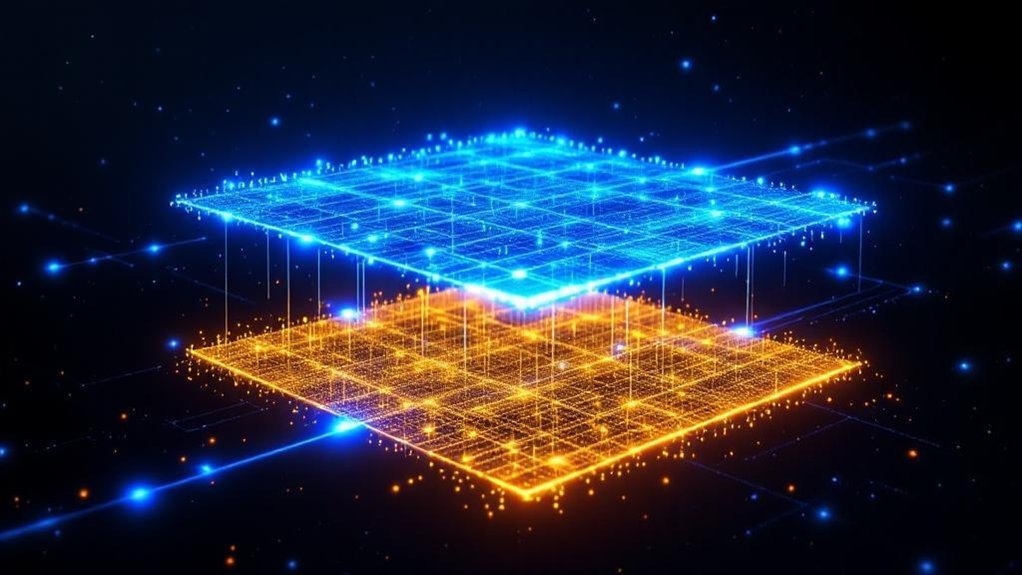Layer 2 solutions tackle blockchain’s biggest headaches: slow speeds and ridiculous fees. These add-on systems process transactions off the main blockchain, bundle them together, and then sync back for security. Think of it like express lanes on a highway – same destination, faster route. Popular options include rollups, state channels, and sidechains. They’re making blockchain actually usable for everyday transactions. There’s a whole world of scaling solutions waiting to be explored.

While blockchain technology promised to revolutionize the digital world, its early iterations hit some major speed bumps. Slow transactions, sky-high fees, and network congestion made using popular chains like Bitcoin and Ethereum about as fun as a root canal. Enter Layer 2 solutions – the blockchain world’s attempt to fix these headaches without compromising security or decentralization.
Layer 2 solutions are basically add-ons built on top of existing blockchains. Think of them as express lanes running parallel to a crowded highway. These protocols process transactions off the main chain, bundle them together, and only occasionally check in with Layer 1 for security purposes. It’s like batch processing for blockchain – efficient, fast, and a whole lot cheaper. Cryptographic proofs ensure all transactions remain secure and valid.
These solutions come in various flavors. Rollups pack multiple transactions into one neat package. State channels let users conduct countless transactions off-chain before settling up. Sidechains operate like semi-independent networks that periodically sync with the main chain. Zero-Knowledge Rollups provide extra security without revealing transaction details. Each approach has its quirks, but they all serve the same purpose: scaling blockchain without breaking it.
The benefits are pretty obvious. Transaction fees drop from painful to painless. Processing speeds jump from glacial to lightning-fast. Users get near-instant confirmation instead of watching paint dry while their transactions pending.
And here’s the kicker – all this comes without sacrificing the security that makes blockchain valuable in the first place.
The impact on the blockchain ecosystem has been transformative. Suddenly, developers can build applications that actually work without bankrupting their users. Microtransactions become feasible. Gaming on blockchain starts making sense. Plasma sidechains offer another powerful option for scaling decentralized applications.
Even regions where high fees made blockchain unusable can join the party. Solutions like Polygon have shown what’s possible when Layer 2 is done right. It’s not perfect – nothing in tech ever is – but it’s making blockchain usable for the masses.
And in the end, that’s what matters.
Frequently Asked Questions
How Much Faster Are Layer 2 Solutions Compared to Layer 1?
Layer 2 solutions absolutely crush Layer 1 speeds.
While traditional Layer 1 blockchains crawl along at 15-30 transactions per second, Layer 2 frameworks can process thousands – we’re talking 2,000-4,000 TPS or more.
Transaction confirmations?
Lightning fast.
Layer 2 gets it done in seconds or less, versus the minutes you’d wait on Layer 1.
Pretty dramatic difference, really.
Layer 2’s off-chain processing is the game-changer here.
Can Layer 2 Solutions Work Across Different Blockchain Networks?
Layer 2 solutions typically don’t work across different blockchain networks.
They’re designed to operate on specific Layer 1 chains – period.
While some bridges and protocols try to connect Layer 2s across blockchains, it’s complex and risky.
Different chains have unique security models and consensus mechanisms, making true cross-chain Layer 2 compatibility a real headache.
Some solutions exist, but they often sacrifice decentralization or security in the process.
What Happens to Layer 2 Funds if the Main Chain Fails?
Layer 2 funds are in serious trouble if the main chain fails – period.
Since Layer 2 solutions depend entirely on Layer 1’s security and consensus mechanisms, a main chain failure means users could lose access to their funds completely.
Can’t withdraw, can’t prove ownership, can’t do much of anything.
Even with fancy safety measures like zero-knowledge proofs, Layer 2s are ultimately only as secure as the blockchain underneath them.
Are Layer 2 Solutions More Vulnerable to Hacks Than Layer 1?
Yes, Layer 2 solutions are typically more vulnerable to hacks than Layer 1.
They introduce extra complexity and attack surfaces through cross-chain bridges, centralized validators, and interoperability requirements.
The proof? Hundreds of millions stolen from Layer 2 bridges alone.
While Layer 1 blockchains benefit from battle-tested security and decentralization, Layer 2s often sacrifice some security for speed.
It’s a classic trade-off – more speed, more problems.
Do Layer 2 Solutions Require Special Wallets for Transactions?
Layer 2 solutions typically don’t require special wallets.
Most work just fine with existing Layer 1 wallets like MetaMask.
Sure, you’ll need a wallet that supports the specific Layer 2 network – but that’s usually just a matter of adding the network details.
Some Layer 2s might need extra features or plugins for the best experience, especially for bridging assets.
But special wallet?
Nah, not really.
